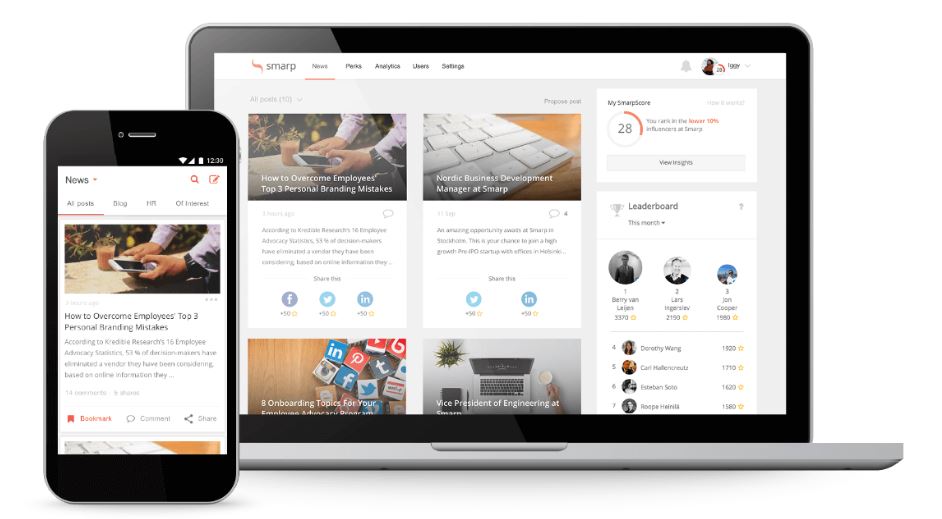
With increasing distrust in information received in content with the recent reports of “fake news” and even “alternative facts”, there is a clear need for change in the way we communicate and trust what is communicated to us. What can brands succeed in this quickly evolving environment?
Real-time communication and social media have changed the workplace. Our peers’ opinions drive our actions: people trust more recommendations and referrals coming from internauts, customers and employees than messages communicated a specific brand. Besides, one of the latest study released by Edelman has shown than employees are perceived as the most trusted spokespeople (2017 Edelman Trust Barometer; slide 47).
More and more organizations are adapting their strategy to this new business environment by integrating social media to their digital communications and by helping their employees becoming ambassadors on social media through employee advocacy.
We spoke with Roope Heinilä, CEO and cofounder of Smarp, the leading app for employee communication, advocacy and engagement. Roope explained us what employee advocacy is, the benefits of implementing an employee advocacy program and he shared tips to make an employee advocacy program a success:
What are the key principles of employee advocacy? How that new market trend is structured?
Employee advocacy is about employees using their own social networks to promote their company, industry and most importantly, themselves as professionals. Employee advocacy, in the digital form, started emerging in 2012 when companies realized that most of their employees had built powerful personal networks on social media, for example on LinkedIn and on Twitter. They started noticing a decline in engagement and reach through their company social media pages. While many brands had first been trying to engage external influencers as their ambassadors, they realized that the people with the biggest interest in the brand and understanding of its vision and goals were their own employees.
In the last year, employee advocacy has evolved from simply having employees share company-related content to actually engaging employees as part of the brand creation process. Companies realize that today, we live in a knowledge based economy where we hire employees not for their physical attributes, but for their knowledge and skills in a certain area. Thereby, employees are almost by definition a great source of influence to their networks and are able to promote the brand while promoting themselves as professionals.
Employees are able to participate on multiple levels from just consuming content to creating it for the brand. While the main principle of employee advocacy will always be turning employees into brand ambassadors, that can only happen with an engaged and influential workforce that a well-run employee advocacy program can foster.
By implementing an employee advocacy program, companies develop their internal communication all while developing their brand awareness, increasing their reach and traffic to their website. In parallel, employee advocacy helps businesses developing an authentic communication strategy and generate more engagement on social media. Indeed, internauts trust employees more than the CEOs of companies when it comes to communication related to the company, they prefer to read personalized messages coming from their peers rather than messages published by the company itself which can be perceived as being too commercial. In a nutshell, word of mouth and recommendations are powerful on social media. It’s all about trust, authenticity and engagement. After all, who would you trust more, a person you know or a brand?
Around which functionalities an employee advocacy platforms is built?
First and foremost employee advocacy platforms are built for the employees, not the companies using them. This is because employee advocacy only works with voluntary participation and for that to happen at scale, the platform must be extremely easy to use and intuitive. This means that it does not really matter how many features the platform has if no one is willing to use it. That said, there are some key elements you should look for in an employee advocacy platform which include:
- Native Mobile apps and web-based platform
- Customizable sharing messages and default sharing messages
- Scalable content distribution structure so the right employee gets the right content at the right time
- Advanced analytics so you can keep improving the program by learning what works and what does not
- Advanced user management and segmentation
- Options to allow employees to submit content with an approval process
- Gamification based on quality, not quantity of sharing. For example, the SmarpScore influencer index informs the employees on their performance as influencers on social media: the score is based on the user’s ability to drive actions such as reshares, likes and clicks from their network. It’s all about rewarding quality instead of quantity.

How generally do companies face the adoption of these new applications?
The first step for a company is to get buy-in to the concept at the top. An employee advocacy program will have tremendous effects on the business both internally and externally and it is important that leadership is involved in championing the program. This is usually fairly easy to achieve as the benefits for the company are very straight forward.
However, it is extremely important that the company communicates clearly the benefits for both the business and employees:
- When demonstrating the benefits for the company, the management should focus on an employee advocacy program that will help the company hitting critical business goals instead of focusing on marketing metrics such as reach and clicks –the goals defined in the employee advocacy program should be tied directly to the company’s strategy such as increasing employee engagement, developing an effective internal communication, increasing engagement on social media.
- For individuals, it should be made clear what is in it for them including staying informed about the company updates, building their personal branding on social media, engaging with their networks, getting recognition from the management and developing their thought leadership by sharing relevant and engaging content with their networks.
The next challenge is content. Without high-quality content the program will not succeed. Companies need to make sure they are choosing the right content for the program and have a good mix of own and curated content. Indeed, it’s important to invite employees discovering both internal and external content to help them staying up-to-date with the company news but also with the latest industry trends.
Content should be added continually to give employees a reason to come back and it should also always be evaluated using the following questions:
- Does this content create value for our employee?
- Does it create value for our brand?
- Does it create value for our employees’ networks?
Finally, there is the choice of the right technology. The solution implemented by the company will have a huge impact on the success of the program. Start by evaluating the user interface and by thinking about it from the employee’s perspective – is this something you would truly use on a daily basis? After this, evaluate how the platform covers the company needs now and in the future. From experience of working with about 200 customers, we can say we have learned a lot about what works and what does not and which knowledge is used to make future launches more successful while avoiding the most common pitfalls.
Could you give us a client use / a use case example of such platforms?
We have launched with one of the Big4 accounting firms back in 2013 one of the world’s first employee advocacy programs involving thousands of employees. While they had been doing referral marketing and employee referrals for recruitment, having a platform enabled them to engage their workforce like never before and to reach over 10 times more people than they could through their own social channels.
The objectives defined in the communications strategy were related to both external and internal communications:
- External communication: increasing the Group’s brand awareness and adding the visibility of its professional people and services. In other words, the objective was to build the brand through the employees rather than through the company itself.
- Internal communication: enhancing employees’ general knowledge of how to use social media in a professional manner and increasing cross-service line knowledge.
The employee advocacy program included gamification to make content-sharing fun and engaging for the employees. Thanks to this program, employees became more engaged and informed as they had constant access to the latest company-related content. In terms of brand awareness and engagement, the group has generated 50K shares, 104K clicks, 20.7M reach, 24K reactions, and the ROI turned out to be 360%.
To conclude, one can say that paradoxically, word of mouth has become a key trend in today’s digital world. Employees are more trusted than the CEOs. Using employee advocacy solutions companies help their employees being well-informed and becoming thought leaders. This new trend, based on authenticity, enables companies to strengthen trust to its potential digital audience but also the engagement of the content.
Nowadays, everyone has access to information and can publish content on social media. Thus more and more companies educate their employees about the best practices when it comes to professional use of social media. Implementing a dedicated employee advocacy program is the best way to help employees becoming ambassadors and developing their personal brand on social media.
Finally, according to Roope Heinilä, CEO and cofounder of Smarp, a user-friendly interface, engaging content and gamification are the key elements to make an employee advocacy program a success. The purpose is not and should not to control employees’ social media activities but to help employees becoming thought leaders on social media. So, are we facing a new area of corporate social communication, or at least of thought leadership? Where everyone would be a brand ambassador of the company he is working for.
| About Smarp:
Smarp is the leading app for employee communication, advocacy and engagement. The app helps organizations developing their internal and external communications by enabling them to quickly create, schedule and publish content for their employees to discover and share on social media. With Smarp, employees stay up to date on the latest company news all while becoming brand ambassadors on social media. By sharing company-related content on social media, they build their personal brand and they develop the company’s brand awareness, employer brand and online reputation. Smarp’s advanced gamification features make participation fun, engaging, and rewarding. The company-level analytics give accurate, actionable insights about user engagement and the personal insights enable employees to easily track their performance as influencers on social media. Visit : http://www.smarp.com/ |



Great article on employee advocacy… If you need to more about employee advocacy, You can check out content out…Great job anyways